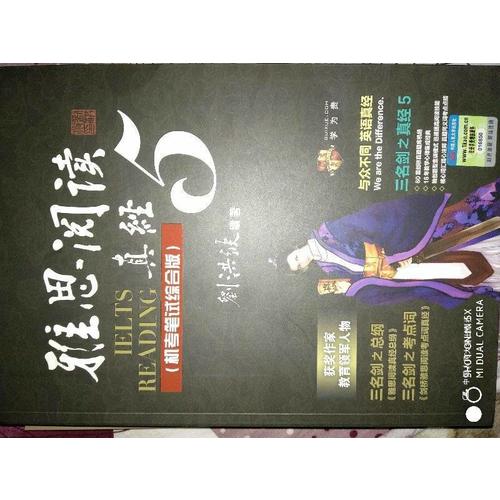本书的改版根据雅思考试动态,融合机考信息,覆盖剑12。《雅思阅读真经5(机考笔试综合版版)》全书包括7章和5个附录。书中的原文与真实的雅思考试如出一辙,原文所涉及的范畴涵盖近几年完整的阅读真题题库。在此基础上,分成7个题型进行有效训练。通过这7种题型的训练,可以熟悉题型特点,印证《雅思阅读真经总纲》中的做题方法,掌握“考点词”,从而达到基础与技巧同时提高、素材与考点同步熟悉的训练目的。书中每篇文章均采用不同的排版方式,力求与雅思真题的呈现模式一致。
书中的附录亦为考生须知。若考生仍有疑问,可按书中所给答疑方式进行咨询。
无论你基础如何,无论你何时考试,《雅思阅读真经5》都是必读的。若基础薄弱,请看《剑桥雅思阅读考点词真经》,若方法迷茫,请看《雅思阅读真经总纲》。三剑合璧,天下无敌!
本书适合所有参加雅思考试的学生,在雅思备考的每一个阶段都是适用的。中国雅思考试官方英国文化处(British Council)认证名师经典作品。《雅思阅读真经5》自出版之日起,一直到今天都是整个培训领域真题命中率高的一本阅读书,代表了整个雅思培训行业对于真题教学研究的高水平,代表了测试和训练的契合方式。从2004年到现在,不论怎样去还原真题,真经永远代表贴近出题原理,而且无可替代的一个品牌。这本书提供给你的不仅仅是真题还原,而是完整的训练方式。通过选择有针对性的训练材料进行分项测试,让考生的阅读能力有实质性飞跃。是的,这就是强悍的真经,可以跟任何一种教学理论相结合的真经,让所有雅思考生感到信赖和骄傲的真经。
刘洪波,学为贵教育创始人,获奖作家,教育领军人物,北京雅思总校校长。年少沉醉于水墨书法,道经音律;后负笈海外,喜两希文化,研习拉丁。归国后投身英语教育事业,培养出大批雅思、托福、四六级、考研英语名师。连续数年赴西部支教,共培训上千名初高中英语教师。
著有《英文字根词源真经》《雅思阅读真经5》《剑桥雅思阅读考点词真经》《剑桥雅思听力考点词真经》《雅思写作真经总纲》《托福阅读考点词真经》等数十部作品。其留学散文被《海外文摘》《青年文摘》等众多媒体登载,广为流传,2013年将其在澳大利亚留学的传奇经历集结成集,出版了《留学SUPER之路》。其2004年出版的《雅思阅读真经》是国内及时本以真题题库为蓝本编写的培训教材,考试命中率极高,畅销海内外,开创了真题机经的教材流派。2007年被各大教育媒体誉为“雅思教父”;2009年当选“建国60年推动中国教育培训发展功勋人物”;入选网易年度 “教育产业十大领军人物”。多次应邀赴剑桥、牛津等名校进行英语教学培训交流研讨。在全国高校巡回演讲数百场,听过其讲座和课程的学员不可胜数。学员点评其授课风格为:行云流水,旁征博引,激情四射,励志人生。
Introduction 介绍
CHAPTER 1 Summary 单词填写题
Reading Passage 1 The Refrigerator
Reading Passage 2 Alfred Nobel
Reading Passage 3 Lost Giant: Mammoth
Reading Passage 4 Tasmanian Tigers
Reading Passage 5 The Lost Continent
Reading Passage 6 Clarence Saunders
Reading Passage 7 Fraud in Science
Reading Passage 8 Graffiti: Street Art or Crime
Reading Passage 9 Ancient Money
Reading Passage 10 Talc Powder
Reading Passage 11 Soviet’s New Working Week
Reading Passage 12 Spectacular Saturn
Reading Passage 13 Thomas Young
CHAPTER 2 True/False/Not Given 句子理解判断题
Reading Passage 14 Yawn
Reading Passage 15 A Brief History of Chocolate
Reading Passage 16 Morse Code
Reading Passage 17 Torch Relay
Reading Passage 18 The Voynich Manuscript
Reading Passage 19 Bondi Beach
Reading Passage 20 The Dutch Tulip Mania
Reading Passage 21 The Benefits of Bamboo
Reading Passage 22 Chinese Yellow Citrus Ant for Biological Control
Reading Passage 23 Animal Self-medication
Reading Passage 24 Rapid, Urban and Flexible
Reading Passage 25 Self-esteem Myth
Reading Passage 26 William Gilbert and Magnetism
CHAPTER 3 Paragraph Heading 段落中心思想题
Reading Passage 27 Pearls
Reading Passage 28 Temperaments and Communication Styles
Reading Passage 29 E-book
Reading Passage 30 Self-marketing
Reading Passage 31 Maps and Atlas
Reading Passage 32 Dyes and Pigments
Reading Passage 33 TV Addiction
Reading Passage 34 Medieval Toys and Childhood
CHAPTER 4 Matching 信息匹配题
Reading Passage 35 Orientation of Birds
Reading Passage 36 Liar Detector
Reading Passage 37 Left-handed
Reading Passage 38 Choice and Happiness
Reading Passage 39 The Father of Modern Management
Reading Passage 40 Ambergris
Reading Passage 41 Interpretation
Reading Passage 42 Barristers and Solicitors
Reading Passage 43 An Exploration of Alchemy
Reading Passage 44 Isambard Kingdom Brunel
Reading Passage 45 Artist Fingerprints
Reading Passage 46 Mental Gymnastics
CHAPTER 5 Multiple Choice 选择题
Reading Passage 47 Koala
Reading Passage 48 Violin Making
Reading Passage 49 El Niño
Reading Passage 50 Booming Bittern
CHAPTER 6 Diagram 图表题
Reading Passage 51 Jethro Tull and Seed Drill
Reading Passage 52 The Oceanographer’s Dream Ship
Reading Passage 53 Travelers’ Accounts
Reading Passage 54 Perfume
Reading Passage 55 From Novices to Experts
Reading Passage 56 Two Wings and a Kit-box
CHAPTER 7 Real Test 真题模考
Test 1
Test 2
APPENDIX 附录
附录1 Answer Keys 答案
附录2 2004—2014 真题一览表
附录3 答疑录
附录4 剑桥大学雅思访问记
附录5 口碑推荐:“绝世好书”《雅思写作真经总纲》
Reading Passage 1
The Refrigerator
Many of the conveniences we enjoy in our homes are the result of years of innovation by dedicated inventors. Though we take many of them for granted, some—like the refrigerator— have hugely affected the way we live our lives. Who invented the refrigerator, and how has it evolved over time?
Early Refrigeration
Preserving food has not always been easy. Centuries ago, people gathered ice from streams and ponds and did their best to store it year-round in icehouses and cellars, so they had a ready supply to keep their food cold. Even with ice, people were often limited to eating locally grown foods that had to be purchased fresh and used daily. The Egyptians, Chinese and Indians were some of the early people to use ice in food preservation. In 1626, Sir Francis Bacon was also testing the idea that cold could be used to preserve meat; his chilly experiment caused him to develop pneumonia, from which he died on Easter Day, April 9, 1626.
Even Peter Mark Roget, compiler of Roget’s Thesaurus, studied refrigeration, suggesting a design for a “frigidarium.” Progress took time, however, and snow and ice served as the primary means of refrigeration until the beginning of the 20th century.
Iceboxes
According to the Association of Home Appliance Manufacturers, one of the next steps between storing ice underground and modern refrigeration was the icebox. Introduced in 19th century England, wooden iceboxes were lined with tin or zinc, and filled with sawdust, seaweed and other materials to keep the ice from melting. Drip pans caught the water that melted and had to be emptied daily.
In the United States, warm winters in 1889 and 1890 caused ice shortages that fueled the need to create a better refrigeration system. An Encyclopedia Britannica entry attributes the beginning of commercial refrigeration to Alexander C. Twinning, an American businessman, in 1856. Later, an Australian named James Harrison reviewed the refrigerator used by Twinning, and another made by physician John Gorrie, and developed vapor-compression refrigeration for the brewing and meatpacking industries.
In 1859, France’s Ferdinand Carré created a more advanced system that used ammonia as a coolant; the earlier vapor-compression machines used air. The ammonia worked well, but was toxic if it leaked. Engineers worked until the 1920s to come up with better alternatives, one of which was Freon.
书没有封皮,送来的时候比较脏了而且封面有很多划痕,但是应该是正版吧毕竟当当自营内容还是挺好的
和描述的一样
自我感觉还不错
真经不是真题……
真的很实用
书皮背压到了
书不错哦买的第二本啦
阅读真经5也太不厚道了,买了书后,做着题到句子理解判断题后看解析,每看一篇解析都需要付费!也太不人性化了,变相赚钱这是,哪有这样子操作的。
不错很好。
内容不错 又买了两本
就是没好好做真经5,7就差一点,有空好好看看!
据说比雅思真题要简单,作为真经的配合书,看完那些技巧之后来做这本,掌握技巧后再去做真题。
 书很厚实,题型涵盖全面。印刷清晰,纸质挺厚的。最新版的更新了一些题目。
书很厚实,题型涵盖全面。印刷清晰,纸质挺厚的。最新版的更新了一些题目。